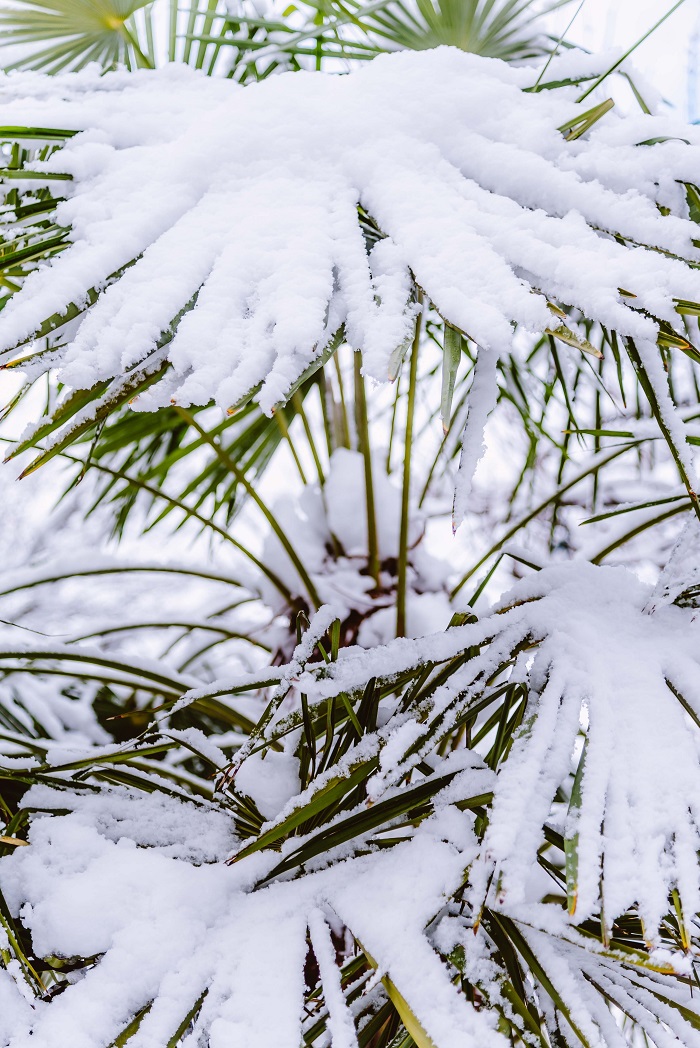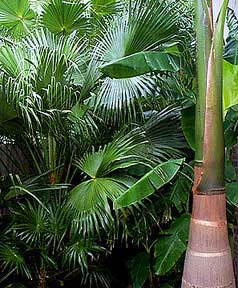As the colder months approach, it’s crucial to understand the importance of winter care for palm trees. While these majestic trees are resilient, they still require special attention to ensure their health and survival during chilly seasons.
In this guide, we will provide you with practical tips and expert advice to help you navigate the challenges of palm tree winter care.
Whether you have a majestic Canary Island Date Palm or a graceful Queen Palm, this comprehensive resource will equip you with the knowledge you need to protect and nurture your palm trees through the colder months.
So, let’s dive in and discover the key strategies for preparing, maintaining, and safeguarding your palm trees during winter. By implementing these tips, you’ll be able to enjoy thriving, vibrant palms that will continue to enhance the beauty of your garden all year round.
Types of Palm Trees
Let’s take a moment to explore some common palm tree varieties. Each palm has its own unique characteristics and may have specific considerations when it comes to winter care.
Canary Island Date Palm (Phoenix canariensis): Known for its impressive stature and robust fronds, the Canary Island Date Palm is a popular choice for landscaping. It requires protection from freezing temperatures and may benefit from additional insulation during winter.
Queen Palm (Syagrus romanzoffiana): With its graceful arching fronds, the Queen Palm adds elegance to any landscape. It is moderately cold-tolerant but can still experience damage during severe freezes. Proper care is crucial to maintain its vitality.
Windmill Palm (Trachycarpus fortunei): The Windmill Palm is a cold-hardy variety that can withstand freezing temperatures better than many other palms. However, it still requires protection in extremely cold climates to prevent damage to its fronds.
By understanding the characteristics and specific needs of your palm tree variety, you’ll be better equipped to provide the appropriate care during winter.
Preparing Palm Trees for Winter
By taking proactive measures, you can help your palm trees withstand the challenges posed by colder temperatures. Below, we outline the simple but important steps to prepare them for the winter season.
1. Mulching: Apply a layer of organic mulch around the base of the palm tree, extending it to the drip line. This will help insulate the roots, retain moisture, and provide some protection against temperature fluctuations.
2. Watering: Adequate hydration is crucial for palm trees during winter. While they may require less water compared to warmer months, it’s important to ensure the soil remains slightly moist. Monitor soil moisture levels and adjust watering accordingly.
3. Frost Protection: In regions prone to frost or freezing temperatures, providing additional protection is vital. Cover the crown of the palm tree with a breathable fabric or blanket during frosty nights. Avoid using plastic as it can trap moisture and cause more harm than good.
4. Wind Protection: Strong winds can damage palm fronds. If your palm tree is exposed to strong winds, consider installing a windbreak or temporary barrier to shield it from excessive gusts.
Remember, prevention is key. By implementing these measures before the onset of winter, you can significantly increase the chances of your palm trees thriving throughout the colder months.
Signs of Cold Damage
Even with proper preparation, palm trees can still experience cold damage during winter. It’s important to be able to identify the signs of cold stress and take fast action to limit harm to the plant. Here are some common indicators of cold damage in palm trees:
1. Browning or Yellowing Fronds: Cold temperatures can cause the fronds of palm trees to turn brown or yellow. This discoloration typically starts from the tips and progresses towards the center of the fronds.
2. Wilting or Drooping Leaves: Cold stress can lead to wilting or drooping of the leaves. They may appear limp and lose their usual turgidity.
3. Stunted Growth: If a palm tree has experienced severe cold damage, its growth may be stunted or delayed. The overall appearance of the tree may seem stunted or less vigorous compared to healthy specimens.
4. Crown Rot: Prolonged exposure to cold and wet conditions can result in crown rot, a fungal infection that affects the growing point of the palm tree. It can lead to the collapse of the central spear leaf and eventually cause the death of the tree.
If you notice any of these signs, it’s important to take quick action. Remember, early intervention is key to increasing the chances of recovery and survival.
Winter Pruning and Maintenance
While winter is a period of dormancy for many plants, it doesn’t mean neglecting your palm trees. Proper pruning and maintenance during this time are essential for their long-term health and aesthetic appeal.
Here are some key considerations:
1. Remove Dead Fronds: Prune away any dead or brown fronds to maintain the overall appearance of the palm tree. Avoid excessive pruning as it can weaken the tree and make it more susceptible to cold damage.
2. Trim Brown Tips: If the fronds have only minor browning at the tips, you can trim them back to improve the tree’s visual appeal. Use sharp, sterile pruning tools to prevent the spread of diseases.
3. Avoid Over-Pruning: It’s important to strike a balance when pruning. Removing too many green fronds can hinder the palm tree’s ability to photosynthesize and thrive. Focus on removing dead or damaged fronds while preserving healthy ones.
4. Inspect for Pests and Diseases: Winter is an opportune time to inspect your palm trees for signs of pests or diseases. Look for any unusual growths, discoloration, or pest activity. If detected, take appropriate measures to address the issue.
By practicing proper winter pruning and maintenance, you promote the overall health and resilience of your palm trees.
Debunking Myths
There are several misconceptions surrounding palm tree care during winter that can lead to improper practices or unnecessary worries.
Let’s debunk some of these myths:
1. Myth: Wrapping the Entire Palm Tree is Necessary. Wrapping the entire palm tree is not necessary or recommended. It can create a moist environment, leading to fungal diseases. Focus on protecting the crown and providing insulation to the root zone instead.
2. Myth: Withholding Water Prevents Cold Damage. While reducing water consumption is advised, completely withholding water is not recommended. Palm trees still require moisture to survive and thrive during winter. Proper watering is crucial, especially during dry periods.
3. Myth: Pruning Should Be Avoided in Winter. Winter pruning is beneficial for palm trees. Removing dead or damaged fronds allows the tree to allocate resources more efficiently. Just ensure you don’t over-prune, as it can weaken the tree.
By separating fact from fiction, you can make informed decisions and provide the best care for your palm trees during winter.
Winter Fertilization and Additional Tips
Winter fertilization plays an important role in maintaining the health and vigor of palm trees during the winter. While their nutrient requirements are reduced, providing some essential elements can support their overall well-being.
Consider the following tips:
1. Choose a Suitable Winter Fertilizer: Look for a slow-release or controlled-release fertilizer specifically formulated for palm trees. These fertilizers release nutrients gradually, providing sustained nourishment over time.
2. Apply Fertilizer Sparingly: Follow the recommended application rates on the fertilizer packaging. Over-fertilization can lead to nutrient imbalances and potential harm to the tree.
3. Focus on Micronutrients: Palm trees often benefit from micronutrient supplementation during winter. Look for fertilizers containing micronutrients like manganese, magnesium, and iron, which play vital roles in palm tree health.
In addition to winter fertilization, here are a few additional tips to ensure the well-being of your palm trees:
– Monitor soil moisture regularly and adjust watering accordingly.
– Avoid excessive pruning during winter to preserve the palm tree’s strength.
– Protect the trunk from mechanical damage, such as accidental impact or injury from garden equipment.
– Keep an eye out for any signs of pest infestation and take appropriate measures if necessary.
By following these tips and best practices, you can help your palm trees thrive during the winter season.
Additional Resources
To further enhance your understanding of palm tree winter care, here are some additional resources you can explore:
1. Books:
– The Palm Trees for Landscaping Guide: The Ultimate Step-by-Step by Dr. Ava Miller
– Your Ultimate Palm Tree Handbook by Darla Wotherspoon
2. Websites:
– The International Palm Society
– University extension websites, such as the University of Florida IFAS Extension
These resources provide comprehensive information on palm tree care, including specific guidance on winter care practices. By delving deeper into these references, you can expand your knowledge and become even more proficient in nurturing your palm trees throughout the winter season.
With proper preparation and maintenance, you can ensure the well-being of your palm trees during winter, allowing them to thrive and beautify your garden for years to come.




